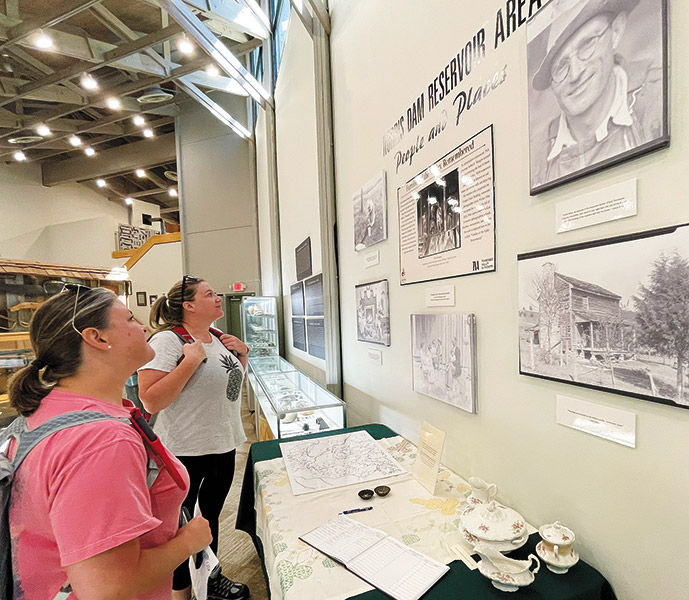Exhibit honors families displaced by Norris Lake

Lenoir Museum visitors Jennifer Mooney, left, and Tiffany Rogers of Knoxville look over the Families of the Valley exhibit of Lewis Hine photographs on Saturday, May 1. (photo:G. Chambers Williams III )
The exhibit, called “Families of the Valley,” takes up part of the first floor and a small area on the second floor of the museum, which sits along Norris Freeway about two miles south of the dam.
Most of the exhibit was coordinated by Michael Mlekodaj, a park ranger and curator of the museum, and Mike Scott, who has been a ranger at the park for 29 years, was raised in the area and now lives on farm property that belonged to one of the displaced families.
“I live on one of the old tracts of the Longmire farm near Sequoyah (Marina),” Scott said. “I grew up on the lake.”
He said he believes the park’s exhibit on the displaced families is important because so many of their descendants still live in the area.
“You can’t move forward until you look to the past — the people that had to be moved, and the CCC Camp people who built the (state) park,” Scott said.
“The cultural resources of this area are amazing,” he said. “All of these are things we try to interpret. We need to preserve and protect it for our children and grandchildren.
“We never want to forget those folks who gave up their land so we could have this beautiful lake. We needed the electricity, the jobs and the tourism it brought.”
The families mostly were relocated in 1933, in preparation for the completion of the dam and flooding of the Clinch and Powell river areas behind it in 1936.
At the time, the U.S. was struggling to pull out of the Great Depression, when jobs were scarce.
The special exhibit will be on display at the Lenoir Museum through the end of May. It focuses on the 2,989 families who were displaced, and was the idea of Norris Dam State Park Manager Veronica Greear.
“It’s part of our park story that hasn’t been told,” she said earlier. “We thought it would be a nice thing to do for those families. I came across some TVA removal papers this past winter that got me thinking about it; that started getting the ball rolling.”
In 1933, the newly formed federal agency known as the Tennessee Valley Authority showed up in the area with plans to build a flood-control and hydroelectric-power dam near the confluence of the Clinch and Powell rivers.
That would become the first in a series of similar dams along the Tennessee River and its tributaries in Tennessee, Alabama and Kentucky.
Greear said the Lenoir Museum exhibit will be open to the public during regular museum hours, from 9 a.m. to 5 p.m. Wednesdays through Sundays.
There are historical documents and some artifacts from the flooded areas on display, as well as photographs by the famous photographer Lewis Hine, who was commissioned by TVA to come to the Norris area for a month in 1933 to document the removal of the families.
The exhibit includes a map of the areas that were taken for the new lake, and descendants of the displaced families can put push pins on the spots of their family’s land, Greears said. “We are also planning to record some oral histories so we can continue to tell their stories.”
Hine also documented the early construction of the dam, building of the CCC camp, and the setting up of the Norris community.
As for the museum exhibits and other events commemorating the displacement of the families, “This whole process is something we want to do once a year,” Greear said. “It’s something that’s long overdue.”
Other programs are planned through the month that complement the theme, Greear said.
For more information, Greear can be contacted at the park office at 865-425-4550.
